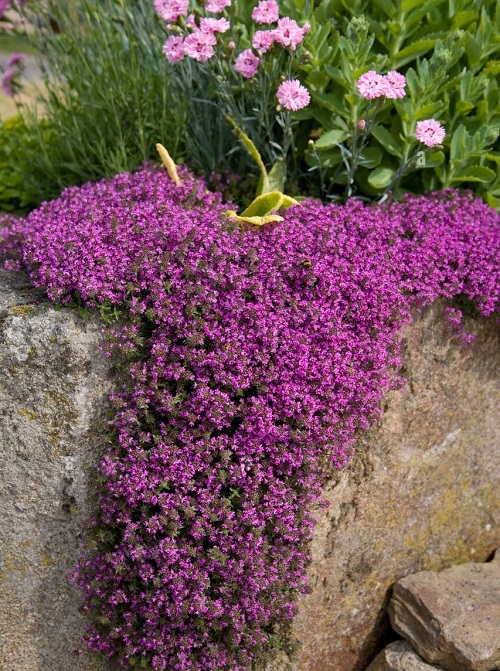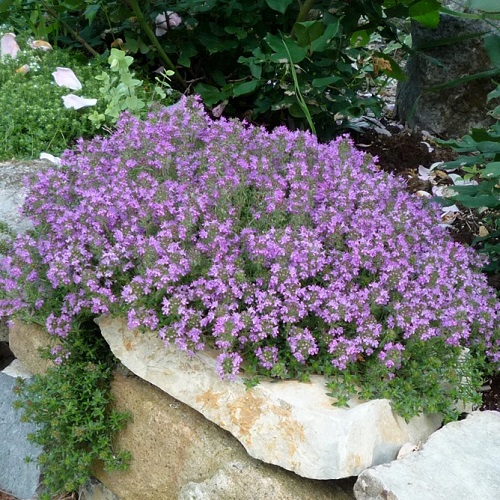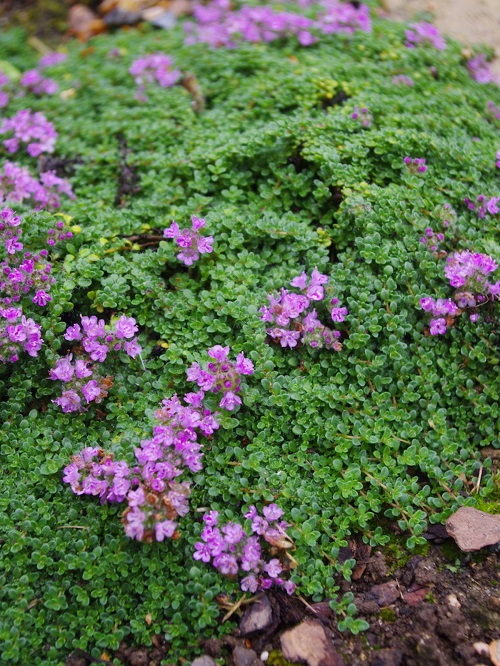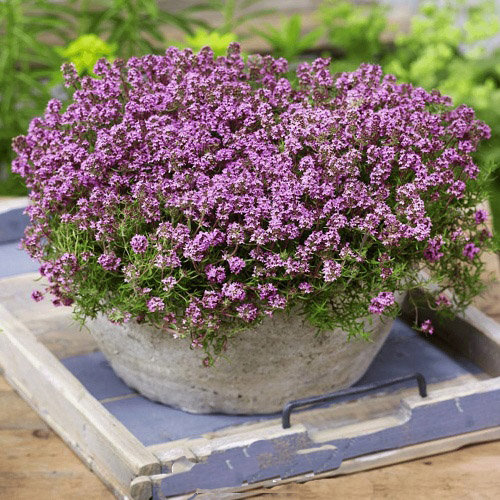Creeping Thyme, like its name suggests, is a fantastic specimen to cover the parts of garden! You can also grow it in pots!
Creeping Thyme is a beautiful plant that adaptable to grow in various conditions. It is easy to look after and also grows stunning flowers!
Botanical Name: Thymus serpyllum
Check out Creeping Thyme Lawn Ideas here
Creeping Thyme Information
Creeping Thyme is a versatile and beautiful herbaceous plant, often used for both culinary and ornamental purposes. Here’s an exhaustive look at its various aspects:
Appearance
- Growth Habit: Creeping Thyme has a low, spreading growth habit, usually reaching a height of 3 to 6 inches (7.5 to 15 cm) and spreading up to 18 inches (45 cm).
- Leaves: Its small, oval, or needle-like leaves are often aromatic, with shades of green, sometimes variegated with silver or gold.
- Flowers: The tiny flowers are typically pink, lavender, or white and appear in clusters throughout late spring and early summer.
Origin
Creeping Thyme is native to Europe and North Africa, particularly in the Mediterranean regions where it thrives in well-drained, rocky, or sandy soils.
History
The plant has been utilized for thousands of years, with records dating back to ancient Greece and Rome. Historically, it’s been used for culinary, medicinal, and ornamental purposes. It was even believed to have magical properties and was a symbol of courage and bravery.
Leaves
- Color and Texture: The leaves are typically green or gray-green, with a fine texture.
- Aroma: The leaves are known for their pleasant and distinctive aroma, a hallmark of many Thyme species.
- Culinary Use: They can be used fresh or dried in cooking to add flavor to various dishes.
Flowers
- Color: Flower colors range from pale pink to lavender to white.
- Bloom Time: Blooming occurs in late spring to early summer.
- Attractiveness to Pollinators: The flowers are attractive to bees and butterflies, making Creeping Thyme a valuable addition to pollinator gardens.
Uses
- Ground Cover: Creeping Thyme is often used as a ground cover in gardens, especially in rock gardens or between stepping stones.
- Culinary Herb: Though not as commonly used as other Thyme species, it’s still an aromatic addition to dishes.
- Medicinal Properties: It’s been used in traditional medicine as an antiseptic, digestive aid, and more.
Check out Best Thyme Growing Tips here
Creeping Thyme in Different USDA Zones
Zone 4
- Minimum Temperature: -30 to -20°F (-34 to -29°C)
- Growing Conditions: Winters are cold, so Creeping Thyme may die back but will typically return in spring. Mulching can help protect the plant from extreme cold.
Zone 5
- Minimum Temperature: -20 to -10°F (-29 to -23°C)
- Growing Conditions: Still subject to cold winters, it is hardy and can handle the chill. As in Zone 4, it may die back but rebound in the warmer months.
Zone 6
- Minimum Temperature: -10 to 0°F (-23 to -18°C)
- Growing Conditions: This zone offers a milder winter climate, making it easier for the plant to flourish. Winter dieback is less common.
Zone 7
- Minimum Temperature: 0 to 10°F (-18 to -12°C)
- Growing Conditions: Zone 7 provides a relatively moderate climate, with warm summers and mild winters. The plant can grow well here with routine care.
Zone 8
- Minimum Temperature: 10 to 20°F (-12 to -7°C)
- Growing Conditions: This zone has even milder winters and longer growing seasons. Creeping Thyme will likely remain evergreen and grow successfully with proper care.
Zone 9
- Minimum Temperature: 20 to 30°F (-7 to -1°C)
- Growing Conditions: In Zone 9, the winters are quite mild, and Creeping Thyme can thrive throughout the year. This zone supports robust growth and flowering.
Propagating Creeping Thyme
Propagating Creeping Thyme can be done through several methods, each with its own set of steps and considerations.
1. Seed Propagation
Steps:
- Preparation: Choose a well-draining soil mix with a pH level of around 7. Fill the pots or trays with the soil mix.
- Sowing: Sprinkle the Creeping Thyme seeds evenly over the soil surface. Lightly press them into the soil without covering them, as they need light to germinate.
- Watering: Mist the soil with water, keeping it consistently moist but not soggy.
- Location: Place the trays or pots in a bright, warm location. A temperature of 70°F (21°C) is ideal.
- Germination: Creeping Thyme seeds usually germinate within 14 to 28 days.
- Transplanting: Once the seedlings have at least two true leaves, transplant them into individual pots or their final growing location.
Find How Vinegar Improves Seed Germination (Proven by Science) here
2. Stem Cuttings
Steps:
- Cutting Selection: Select healthy, vigorous Creeping Thyme stems that are not flowering.
- Cutting Preparation: Cut a 3-4 inch (7.5-10 cm) piece just below a leaf node. Remove the leaves from the lower half.
- Rooting Hormone: Dip the cut end in rooting hormone powder to encourage root growth (optional).
- Planting: Insert the cut end into a pot filled with moist, well-draining soil mix.
- Care: Cover the pot with a plastic bag or place it in a propagator to maintain high humidity. Keep the soil moist.
- Rooting: Cuttings typically root in 4-6 weeks. Once rooted, transplant to the desired location.
Propagate Any Plant Cutting Quickly Using this Trick
3. Division
Steps:
- Plant Selection: Choose a healthy, well-established Creeping Thyme plant.
- Digging Up: Carefully dig up the entire plant, taking care not to damage the roots.
- Division: Using your hands or a clean, sharp knife, divide the plant into smaller sections. Ensure that each section has both roots and shoots.
- Planting: Replant the divisions at the same depth they were growing before, in a location with similar growing conditions.
- Watering: Water the divisions well to help them establish in their new location.
4. Layering
Steps:
- Selecting Stems: Choose a healthy, flexible Creeping Thyme stem that can be bent to the ground.
- Bending: Bend the stem to the ground and lightly wound the part that will be buried.
- Planting: Bury the wounded part of the stem in the soil, leaving the tip exposed.
- Anchoring: Use a U-shaped stake or a rock to keep the stem in contact with the soil.
- Rooting: The buried part of the stem will develop roots over time.
- Cutting and Transplanting: Once rooted, cut the newly rooted plant from the parent and transplant it to the desired location.
Ideal Timing:
The best time to propagate the plant is in the spring or early fall when it is actively growing but not in its peak growing season. This gives the plant time to establish itself before facing more extreme weather conditions.
Discover the Best Walkable Ground Covers here
Types of Creeping Thyme
Creeping Thyme comes in a wide variety of cultivars, each with its own unique attributes, colors, and growth habits. While it’s hard to enumerate every single variety as new ones are being developed all the time, here’s an overview of some of the popular types:
1. Thymus serpyllum ‘Coccineus’ (Red Creeping Thyme)
- Appearance: Dark green leaves with bright magenta-red flowers.
- Use: Ideal for ground cover or rock gardens.
2. Thymus serpyllum ‘Albus’ (White Creeping Thyme)
- Appearance: Green leaves with white flowers.
- Use: Popular in contrast plantings or as a border.
3. Thymus serpyllum ‘Pink Chintz’ (Pink Creeping Thyme)
- Appearance: Soft pink flowers with fuzzy, olive-green leaves.
- Use: Works well between stepping stones or as a lawn substitute.
4. Thymus serpyllum ‘Elfin’ (Elfin Thyme)
- Appearance: Tiny, dark green leaves with lavender-pink flowers.
- Use: Great for planting between rocks or in crevices in walls.
5. Thymus serpyllum ‘Minor’ (Minor Creeping Thyme)
- Appearance: Dense growth with small dark green leaves and light lavender flowers.
- Use: Effective ground cover for large areas.
6. Thymus serpyllum ‘Goldstream’ (Lemon Creeping Thyme)
- Appearance: Variegated leaves with a lemony fragrance and light pink flowers.
- Use: Suitable for borders and rock gardens.
7. Thymus serpyllum ‘Highland Cream’
- Appearance: Green leaves with creamy white edges and soft pink flowers.
- Use: Attractive in mixed plantings or as a border.
8. Thymus serpyllum ‘Reiter’s’ (Reiter’s Thyme)
-
- Appearance: Blue-green leaves and lavender to pink flowers.
- Use: Often used as a lawn substitute or in rock gardens.
9. Thymus serpyllum ‘Magic Carpet’ (Magic Carpet Thyme)
- Appearance: Dark green leaves with vibrant pink flowers.
- Use: Ideal as a low-growing ground cover.
Check the Best Types of Creeping Thyme Varieties
Best Pot Size for Creeping Thyme
Initial Pot Size
- Pot Size: A pot that is 8 to 12 inches (20 to 30 cm) in diameter is generally a good starting size for Creeping Thyme. Go for a wider pot as the plant creeps!
- Depth: It should also be at least 8 to 10 inches (20 to 25 cm) deep to allow for proper root development.
- Drainage: Make sure the pot has adequate drainage holes to prevent waterlogging, as Creeping Thyme prefers well-drained soil.
Best Time to Repot
- When to Repot: Repotting can be done when the plant has outgrown its current pot, which is often indicated by roots growing out of the drainage holes or the plant appearing crowded.
- Season: Early spring, just before the new growing season, is typically the best time to repot Creeping Thyme. This gives the plant ample time to settle into its new home before the growing season.
Here are Plant Pot Sizes from Inches to Gallon
Next Pot Size
- Next Pot Size: When repotting, it’s usually best to choose a pot that is 2 to 4 inches (5 to 10 cm) larger in diameter than the current pot. This gives the roots room to grow without putting too much soil around the plant, which could retain excessive moisture.
- Consider Growth Habit: Since Creeping Thyme tends to spread, a wider pot rather than a much deeper one is preferable. This allows the plant to grow in its natural spreading habit.
Requirements for Growing Creeping Thyme
1. Sunlight
- Light Requirements: Creeping Thyme thrives in full sun, meaning it requires at least 6 to 8 hours of direct sunlight per day.
- Partial Shade: It can tolerate some partial shade, especially in hot climates, but too much shade can lead to leggy growth and fewer flowers.
- Expert Tip: Place it in a location where it will receive consistent sunlight throughout the day, and avoid planting in heavily shaded areas to ensure robust growth and flowering.
2. Water
- Watering Needs: Creeping Thyme is drought-tolerant once established, but it will need regular watering during its first growing season.
- Frequency: Water the plant thoroughly when the soil is dry to the touch. Over-watering can lead to root rot.
- Irrigation Method: Use a soaker hose or drip irrigation to provide slow and deep watering, which encourages strong root development.
- Expert Tip: Watering in the morning helps prevent fungal diseases by allowing the foliage to dry out during the day.
3. Soil
- Soil Type: Well-drained soil is essential for Creeping Thyme. Sandy or loamy soils with good drainage are ideal.
- pH Level: Neutral to slightly alkaline soil with a pH range of 6.5 to 7.5 is preferred.
- Soil Amendments: Mixing in organic matter or compost can improve soil texture and fertility.
- Expert Tip: If planting in a container, use a high-quality potting mix designed for herbs or succulents, possibly adding some sand or perlite to ensure proper drainage.
4. Temperature
- Hardiness Zones: Creeping Thyme is hardy in USDA Zones 4 to 9, meaning it can tolerate a wide range of temperatures.
- Heat Tolerance: It can grow in hot climates but may benefit from some afternoon shade in extremely hot areas.
- Frost Tolerance: As a perennial, it can survive frost but will die back in winter and re-emerge in spring in colder zones.
- Expert Tip: Mulching around the base of the plant can help regulate soil temperature, retaining warmth in cooler climates and keeping the roots cool in hot weather.
Discover the Best Flowering Ground Cover Plants here
Creeping Thyme Care
1. Fertilizer
- Fertilizer Needs: Creeping Thyme generally requires minimal fertilization, as excessive nutrients can lead to soft growth and reduced flavor in culinary varieties.
- Type: A balanced, slow-release granular fertilizer with equal amounts of nitrogen, phosphorus, and potassium (e.g., 10-10-10) can be used.
- Timing: Apply in spring as new growth appears, following the manufacturer’s instructions. If you see a slow growth, apply again in the mid season.
- Expert Tip: Consider a soil test to determine nutrient deficiencies, if any. Organic alternatives such as compost or well-rotted manure can provide nutrients and improve soil texture.
2. Pruning
- Pruning Needs: Light pruning can help maintain the shape, promote denser growth, and remove dead or diseased parts.
- When to Prune: Best done after flowering in late summer to encourage new growth without affecting flower production.
- How to Prune: Use clean, sharp scissors or pruning shears to trim back up to one-third of the plant, focusing on leggy or overgrown areas.
- Expert Tip: Regularly remove spent flowers (deadheading) during the blooming season to encourage continuous flowering.
3. Pests
- Common Pests: It is relatively pest-resistant but may be affected by spider mites, aphids, or whiteflies.
- Control Measures: Introduce beneficial insects like ladybugs, use insecticidal soap, or remove affected parts manually.
- Expert Tip: Regular inspection and early intervention are crucial. Keep the growing area clean and well-spaced to reduce pest attraction.
4. Diseases
- Common Diseases: The plant may suffer from root rot, powdery mildew, or fungal leaf spots.
- Prevention: Ensuring proper soil drainage, spacing, and air circulation will minimize disease risk.
- Treatment: Fungicides can be used as directed for severe cases, but often, removing affected parts and improving growing conditions is sufficient.
- Expert Tip: Watering at the base of the plant rather than overhead will reduce the risk of fungal diseases.
Explore Everything About Growing Chervil here
Creeping Thyme – Why It Is a Great Grass Alternative
Creeping Thyme offers a visually appealing, low-maintenance, and eco-friendly alternative to traditional grass lawns. It’s drought tolerance and minimal care requirements can save time and resources, making it an excellent choice for sustainable landscaping. Here’s why you might consider Creeping Thyme as a great grass alternative:
1. Low Maintenance
- Watering Needs: It is drought-tolerant, requiring significantly less water compared to traditional grasses.
- Mowing: Unlike grass, it doesn’t need regular mowing, saving both time and energy.
- Fertilization: Minimal to no fertilization is needed, reducing the input of chemicals into the environment.
2. Aesthetic Appeal
- Visual Impact: Creeping Thyme provides a lush, green carpet accented with delicate, aromatic flowers. The visual texture can add interest and beauty to landscapes.
- Seasonal Interest: Many varieties offer extended blooming periods, adding color throughout the growing season.
3. Eco-Friendly
- Pollinator Attraction: The flowers attract bees, butterflies, and other beneficial pollinators, contributing to local ecosystems.
- Soil Erosion Control: Its dense growth habit helps prevent soil erosion, particularly on slopes or embankments.
4. Foot Traffic Tolerance
- Resilience: Some varieties are robust enough to withstand light foot traffic, making them suitable for pathways or areas around stepping stones.
5. Aromatic Qualities
- Fragrance: The foliage of Creeping Thyme releases a pleasant aroma when stepped on, adding a sensory dimension to the garden.
6. Weed Suppression
- Dense Growth: Its thick growth habit can help suppress weed growth, reducing the need for weeding and herbicides.
7. Versatility
- Growth in Various Conditions: Creeping Thyme can grow in various soil types and is adaptable to different climate zones, as mentioned earlier (USDA Zones 4 to 9).
8. Disease and Pest Resistance
- Health: Creeping Thyme is generally resistant to common pests and diseases, reducing the need for chemical treatments.
Creeping Thyme – Frequently Asked Questions
1. What is Creeping Thyme?
Answer: It is a low-growing, spreading perennial herb known for its fragrant foliage, attractive flowers, and culinary and ornamental uses.
2. Can Creeping Thyme be Used in Cooking?
Answer: Yes, it can be used as a culinary herb, adding a subtle, earthy flavor to various dishes.
3. How Much Sun Does Creeping Thyme Need?
Answer: The plant thrives in full sun, requiring at least 6 to 8 hours of direct sunlight daily.
4. How Often Should I Water Creeping Thyme?
Answer: Water when the soil is dry to the touch, being careful not to over-water. It is drought-tolerant once established.
5. What Kind of Soil is Best for Creeping Thyme?
Answer: Well-drained sandy or loamy soil with a pH of 6.5 to 7.5 is ideal for Creeping Thyme.
Explore Tips on How to Grow Fragrant Rosemary here
6. When and How Should I Prune Creeping Thyme?
Answer: Prune after flowering in late summer, trimming back up to one-third of the plant to maintain shape and promote growth.
7. Does Creeping Thyme Attract Bees?
Answer: Yes, its flowers attract bees, butterflies, and other pollinators, making it a valuable addition to pollinator-friendly gardens.
8. Can Creeping Thyme be Grown Indoors?
Answer: While typically grown outdoors, Creeping Thyme can be grown indoors with sufficient light and proper care.
9. How Do I Control Pests and Diseases in Creeping Thyme?
Answer: Regular inspection, proper spacing, well-drained soil, and natural pest controls like beneficial insects or insecticidal soap can help manage pests and diseases.
10. Can I Grow Creeping Thyme as a Lawn Substitute?
Answer: It is often used as a ground cover or lawn substitute due to its low-maintenance needs and ability to withstand light foot traffic.
11. How Do I Propagate Creeping Thyme?
Answer: It can be propagated through seeds, cuttings, or division of established plants.
12. Is Creeping Thyme Deer Resistant?
Answer: It is generally considered deer-resistant, making it suitable for gardens in deer-prone areas.










